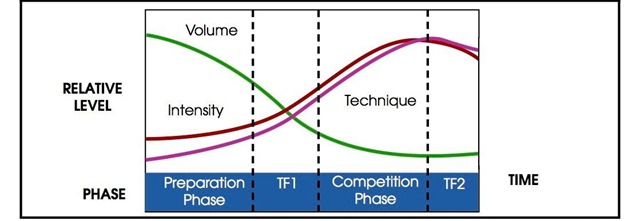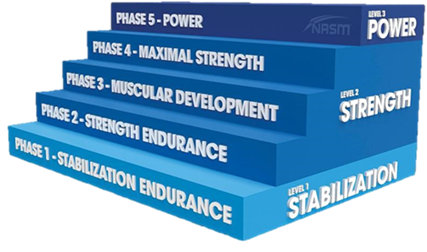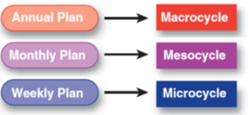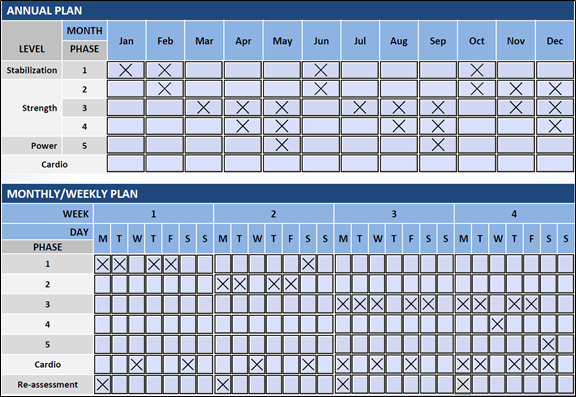Have you ever wondered how elite trainers leverage periodization and programming to maximize results?
In this blog, we will explain the underlying principles that drive planning, periodization, cycles, and phases to help you improve program effectiveness - all of which is backed by the NASM-CPT curriculum and OPT™ Model.
What is training periodization?
Periodization requires the application of planned phase changes and cycles in programming to drive physical and metabolic adaptations to improve performance. This was first defined by Russian physiologist Leo Matveyev in the mid-1960s after analyzing Soviet athletes in the 1952 and 1956 summer Olympics. This systematic approach has since been further developed and applied to sport-specific goals to achieve optimal performance and increase athletic potential.
In 2001, the International Olympic Committee awarded Ukrainian professor Vladimir Platonov the Olympic Order for his comprehensive work developing a general theory of Sports Training Periodization. This theory was grounded on Matveyev’s work and expanded upon to emphasize specific concepts.
A great example is an emphasis on multi-cycle periodization models rather than limiting programming to mono, two- or three-cycle annual periodization's.
The general theory presented by Platonov is that periodization is dynamic and should be adapted to the sport-specific (or athlete-specific) goal. Allowing adequate time in the preparation phase is imperative to reaching peak performance and injury avoidance. The increased work capacity developed in the strength endurance phase, for example, improves the ability to complete higher intensity, higher volume workouts in subsequent phases such as muscular development and power.
Figure A) Matveyev Periodization Model

In Matveyev’s, model the fundamental concept is that training should gradually progress from high-volume/low-intensity to low-volume/high-intensity to prepare an athlete for peak performance. Tools such as Hans Selye’s General Adaptation Syndrome (GAS), Specific Adaptations to Imposed Demands (SAID) Principle, and Progressive Overloading (PO) are great examples of mechanisms that support the periodization model.
* General Adaptation Syndrome – Used to describe how the body responds and adapts to stress. For adaptations to occur, the body must be confronted with a stressor of some form that creates the need for a response.
* Three stages of response to stress: alarm reaction, resistance development, exhaustion.

What are the Periodization phases?
1. Stabilization Endurance: Focus on intrinsic core and prime movers to improve flexibility and stabilization to prepare the body for strength training
a. Low to moderate set volume 1-3
b. Moderate to high repetitions 12-20+
c. Low to moderate training intensities 50-70% 1RM
d. Slow tempo 4/2/1
e. Longer rest periods 0-90 sec
f. Low/Moderate training frequency 2-4 times/week
g. 1-2 stabilization progressions per muscle group
2. Strength Endurance: Improve muscular endurance to increase work capacity to support higher training intensities of subsequent phases
a. Low to moderate set volume 2-4 (Superset Strength x Stability)
b. Moderate to high reps 8-12
c. Low to moderate training intensities 50-70% 1RM
d. Superset a strength-focused exercise with a stability-focused exercise
e. Moderate (2/0/2) and Slow tempo (4/2/1)
f. Moderate rest periods 0-60 sec
g. Low/Moderate training frequency 2-4 times/week
h. 1 strength + 1 stabilization exercise per muscle group
3. Muscular Development: Maximize muscular development and growth, increase protein synthesis, improve strength, and body composition
a. Moderate/High set volume 3-5
b. Moderate repetitions 6-12
c. Moderate/High training intensities 75-85% 1RM
d. Moderate tempo 2/0/2
e. Moderate rest periods 0-60 sec
f. Moderate/High training frequency 3-6 times/week
g. 2-4 strength exercises per muscle group
a. High set volume 4-6
b. Lower repetitions 1-5
c. Moderate/High training intensities 85-100% 1RM
d. Explosive tempo
e. Longer rest periods 3-5 min
f. Moderate training frequency 2-4 times/week
g. 1-3 strength exercises per muscle group (typically compound movements)
5. Power: Recruitment of maximum muscle fiber to increase strength and power output
a. Moderate set volume 3-5
b. Lower repetitions 1-5 (str) + 8-10 (pwr)
c. Low x High training intensities 85-100% 1RM (str) x 30-35% 1RM (pwr) or 10% of BW
d. Superset Explosive tempo (str) x plyo tempo (pwr)
e. 1-2 min rests between pairs, 3-5 min between circuits
f. Moderate training frequency 2-4 times/week
g. 1 strength exercises per muscle group x 1 power

What are the variables of periodization and training phases?
• Timing/Cadence (Concentric vs Eccentric)
• Force, loading (i.e., %1RM)
• Rest intervals between sets
• Horizontal vs Vertical loading
• Volume of reps and sets
• Time under tension
• Training frequency, distance, or duration
• Exercise selection & variety, bilateral vs unilateral exercise
• Distal joint position: Open-Kinetic Chain vs Closed-Kinetic Chain training
• The training split and prioritization of specific muscle groups
What are the 3 types of cycles (macro, meso, micro) used for periodization?
Cycles are essential parts of the planning process used in developing periodization strategies.
1. Macrocycle
a. Macrocycles refer to the high-level cycles used to plan out periodization over a longer length of time such as several months, or annually.
2. Mesocycle
a. Mesocycles cover intermediate lengths of time that take the macrocycle and break it down into more specific phases over several weeks or months.
3. Microcycle
a. The microcycle is the most granular and focuses on the acute training differences in daily or weekly segments.

Example of macro/meso/micro cycle

Should a Training Phase Last?
The length of a training phase varies and is dependent upon client progression and goals.
Note that mechanisms such as progressive overloading allow you to remain in a specific phase (i.e., Muscular Development for bodybuilding) for longer periods without risking a plateau. The most critical phase is the preparatory phase (i.e., stabilization endurance) to adequately prepare the client for the imposed demands and greater training intensities down the road. This phase is dynamic and should be determined by the client and goal.
The variations are acute variables such as training intensity and volume are necessary to keep the client progressing and avoid a plateau. Without a variable stimulus, the neuromuscular system will adapt to the current training over time and a good rule of thumb for most general fitness clients is planning a phase change every 4-6 weeks, or as needed to avoid plateau based on client progress.
However, it is not uncommon to see phase shifts every 1-6 weeks. Adaptations can also be achieved within the same training phase by way of the SAID principle and Progressive Overloading.
What is the Difference Between Linear Periodization and Undulating Periodization?
Linear periodization refers to increasing specific variables each workout or weekly whereas undulating periodization involves the application of cycling through variables to impose a multifaceted demand and achieve the desired result.
An example of linear periodization is adding weight (load) to a given exercise each training session until that 4- or 8-week block is completed. An example of undulating periodization would be doing a high-volume / low-intensity session followed by a low-volume / high-intensity session the following week.
This variation can cause muscle confusion and keep the client progressing to a dynamic stimulus. Training in an 8-week block leading up to a Powerlifting meet would be a good place to implement linear periodization. Bodybuilding or similar athletic competitions may be good opportunities to leverage undulating periodization.
For more on the difference, check out the NASM-CPT podcast episode below.
Why is Periodization Important?
Without the use of periodization, the client/athlete may not reach full potential. Each phase builds upon the last as the physical and metabolic adaptions occur, working capacity improves, and the body prepares for higher intensities and loading in training. These techniques can be leveraged in numerous ways to develop a more sport-specific and individualized plan to meet client goals.
How Do You Write a Periodization plan for a client?
This is centered around client goals and starting point. For example, an elderly sedentary person is going to have a very different periodization model than an athlete. By starting with the end goal in mind, the trainer can map out an appropriate periodization plan that gradually prepares the client for maximal performance and injury avoidance.
Begin by assessing the client’s current physical condition and developing an adequate preparation phase that aligns with client objectives and lays the framework for the full plan. This will serve as a guide as the macrocycle is mapped out with appropriate phases scheduled over several months or year(s).
Next, you will drill deeper by breaking the macrocycle into smaller sections such as weeks or months which will become the mesocycle. In the mesocycle the strategy will have more specific details around timing and when phase changes will occur from week to week.
Lastly, before you begin programming you will get even more granular by crafting the daily/weekly periodization plan or microcycle. You may choose linear or undulating periodization, specify what days each phase will be applied, and determine what variables will change.
The goal of periodization is to maximize client performance by gradually increasing the intensity in exchange for volume-loading over time, helping the client reach their peak potential.
About the author
Andre Adams is a professional athlete with the International Federation of Bodybuilding (IFBB) pro league, having competed in the 2015 Mr. Olympia and Arnold Classic professional physique divisions. Andre has also coached hundreds of athletes and clients.
He is also a Master Trainer with the National Academy of Sports Medicine® (NASM), physique contest prep coach, and holds several specializations with NASM. Certifications include: NASM-CPT, WFS, PES, WLS, GPTS, FNS and MT.
Instagram: @AndreAdams_Official
References
Tools and Benefits of Periodization: Developing an Annual Training Plan and Promoting Performance Improvements in Athletes https://thesportjournal.org/article/tools-and-benefits-of-periodization-developing-an-annual-training-plan-and-promoting-performance-improvements-in-athletes/
Review of Platonov’s “Sports Training Periodization. General Theory and its Practical Application” – Kiev: Olympic Literature, 2013 https://www.ncbi.nlm.nih.gov/pmc/articles/PMC4327377/












